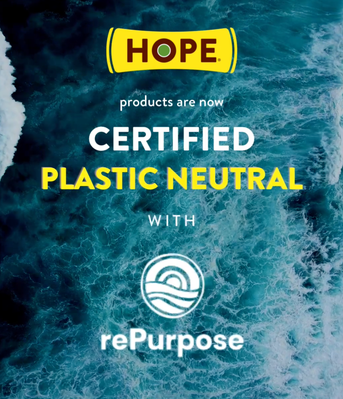How Hope Foods shares its sustainability story with consumers
Two of Hope Foods' marketing executives explain how they use omnichannel, mission-driven marketing to share the brand's sustainability story.

Earlier this year, Hope Foods, which creates plant-based dips and spreads, announced it had received Plastic Neutral Certification from rePurpose Global across its entire product line. A leading Plastic Action Platform, rePurpose Global removes and properly processes plastic that would otherwise end up in places it does not belong, harming the earth.
Sustainability today is top of mind for consumers, and they feel better about their purchases if they are made aware that a product is reducing its impact on the planet. While pricing and quality may still be the driving factors behind purchase decisions, transparent storytelling gives a product that extra bump in creating trust with consumers, who might become loyal repeat buyers.
Hope Foods' Nicole Pavlica, VP of marketing, and Aubrea Alford, marketing and brand manager, explain how they tell their brand’s sustainability story through mission-driven marketing.
How is sustainability a part of your marketing strategy? Describe your sustainability storytelling journey.
HF: To ensure alignment across the organization and ongoing optimization, we have global key performance indicators that guide earth- and human-first decision-making well before it becomes a marketing strategy. These key actions are liked to corporate, departmental and individual performance plans that are tracked, measured and modified on a regular basis.
How do you communicate your brand’s sustainability efforts? What platforms have you found work best?
HF: Our communication strategy is omni-channel. We communicate our points of differentiation, including our sustainability efforts, at varied points along the consumer journey, varying the way we communicate based on the medium or consumer’s mindset at that point in the purchase cycle. Media types include PR, social media platforms, our packaging, our website, email marketing, and on occasion, shopper marketing. As with all marketing messages, brands need to speak to consumers in the channels that they use to make purchase decisions and construct the copy to address the consumer’s need at that point.
What information do you think is critical to have on your website?
HF: Websites are a great place for effortlessly addressing common consumer questions (i.e., is your package recyclable?) as well as providing detailed explanations of key efforts. These often live within an “About Us” or “Our Promise” page. Websites are an important hub for information, but analytics show how little time consumers actually spend reading the content brands create. Web content should be relevant, pithy and amplified in other channels within the media mix.
How do you avoid greenwashing?
HF: We integrate sustainability action items into our corporate and personal goals. This ensures that sustainability is top of mind at all levels of our organization and that everyone is held accountable for achieving the goals set. This becomes the foundation for a number of other key actions, including documentation, third-party audits, legal reviews, monthly production reviews, etc. We’ve recently begun applying for B-Corp certification, and that process has illuminated where we are strong and where we can increase efforts. It’s a great self-reflection tool that has inspired us to consider additional action items/processes.
How do you prioritize certain messaging or copy when, for example, you cannot fit a product’s entire story in one IG post?
HF: The days of “matching luggage” in terms of marketing creative are over; effective communication must be varied based on the audience, mindset and medium. Testing which messages/imagery/channels resonate best takes time, but doing so is important for optimizing ROI or ROE (return on engagement). Websites and blogs are great places to house more details for audiences seeking more details.
How do you get the consumer to feel involved in your sustainability story?
HF: We tell consumers how they help us make a bigger impact, and we build activation programs—communicating in social media, PR and other digital platforms—that they can participate in.
What are your thoughts on transparency and honesty about sustainable setbacks or things your brand cannot yet achieve?
HF: Implementation of sustainability efforts in every area of any business requires a significant number of resources. Making progress within a business’s capacity is perfection, and we believe it’s important, to be honest about the steps taken and to be taken.
Read more about:
PackagingAbout the Author
You May Also Like





